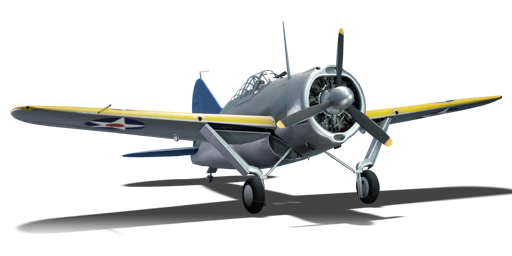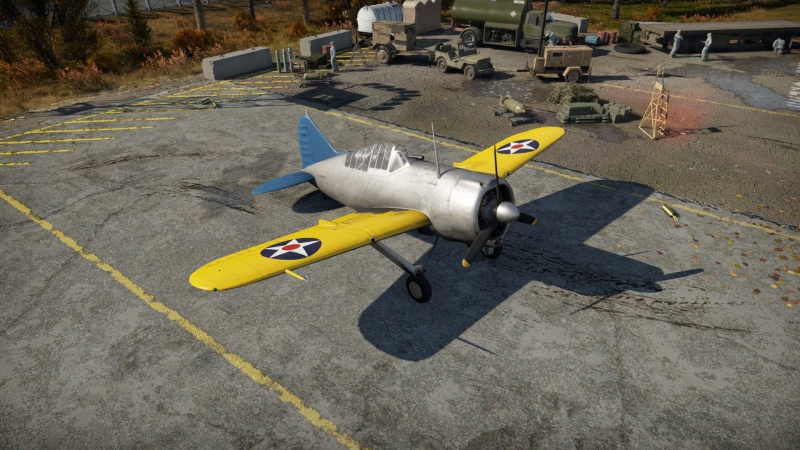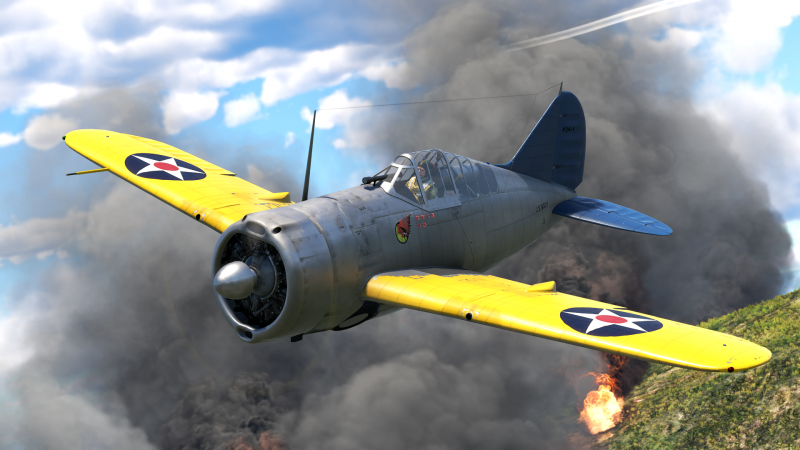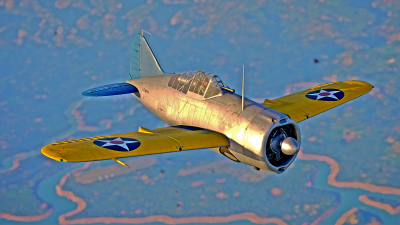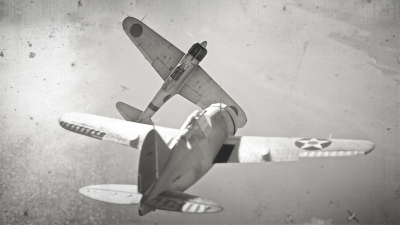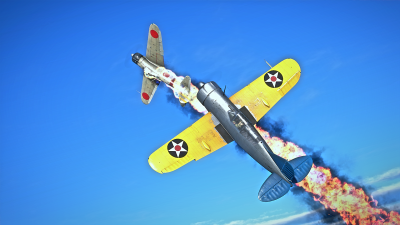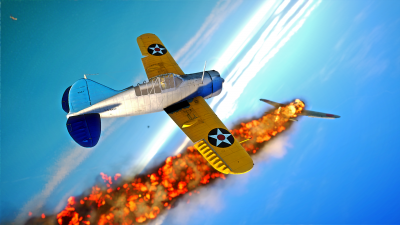Difference between revisions of "F2A-1"
Inceptor57 (talk | contribs) (Fix shortened link to correct section) |
m (→Flight performance: RB stock performance) (Tag: Visual edit) |
||
| (25 intermediate revisions by 14 users not shown) | |||
| Line 1: | Line 1: | ||
| + | {{About | ||
| + | | about = American fighter '''{{PAGENAME}}''' | ||
| + | | usage = other versions | ||
| + | | link = F2A (Family) | ||
| + | }} | ||
{{Specs-Card | {{Specs-Card | ||
|code=f2a-1 | |code=f2a-1 | ||
| − | | | + | |images={{Specs-Card-Image|GarageImage_{{PAGENAME}}.jpg|ArtImage_{{PAGENAME}}.png}} |
| − | + | |cockpit=cockpit_f2a-1.jpg | |
| − | {{ | ||
| − | | | ||
| − | | | ||
| − | | | ||
| − | |||
| − | |||
| − | |||
}} | }} | ||
== Description == | == Description == | ||
<!-- ''In the description, the first part should be about the history of and the creation and combat usage of the aircraft, as well as its key features. In the second part, tell the reader about the aircraft in the game. Insert a screenshot of the vehicle, so that if the novice player does not remember the vehicle by name, he will immediately understand what kind of vehicle the article is talking about.'' --> | <!-- ''In the description, the first part should be about the history of and the creation and combat usage of the aircraft, as well as its key features. In the second part, tell the reader about the aircraft in the game. Insert a screenshot of the vehicle, so that if the novice player does not remember the vehicle by name, he will immediately understand what kind of vehicle the article is talking about.'' --> | ||
| − | + | The Brewster F2A Buffalo was a revolutionary carrier-based monoplane designed to replace the outdated biplanes that were previously in service with the United States Navy. It was introduced as a much-needed upgrade to the fleet's aircraft, boasting impressive features such as a 950 horsepower engine and a total of four machine guns. The armament of the F2A-1 was distributed across different parts of the aircraft, with two machine guns of different calibers (a .50 cal or 12.7 mm and a .30 cal or 7.62 mm) situated in the nose, and two more machine guns on each wing, making it a formidable fighter. | |
| − | |||
| − | The | ||
| − | The Brewster F2A Buffalo was | + | The Brewster F2A Buffalo was a popular aircraft not only in the United States but also in many other countries. In fact, the Finnish Air Force was highly successful with [[B-239 (Sweden)|theirs]], and they managed to take down numerous Soviet fighters using this aircraft. However, by the time World War II began and the Attack on Pearl Harbor occurred, the F2A-1 was outclassed by the Japanese [[A6M2]] and [[Ki-43-I|Ki-43s]], which were much more advanced and formidable opponents. |
| − | + | In the game since the start of the Open Beta Test prior to Update 1.27, one of the Brewster F2A Buffalo's most significant advantages is its balance of speed and manoeuvrability. It is capable of outrunning biplanes and can out-turn most monoplanes. The F2A-1's armament of .50 calibre machine guns also allows it to pack a serious punch in combat. As a result, this plane is ideal for getting a pilot accustomed to the American style of playing using the "Boom & Zoom" tactic. | |
== General info == | == General info == | ||
=== Flight performance === | === Flight performance === | ||
| − | ''Describe how the aircraft behaves in the air. Speed, manoeuvrability, acceleration and allowable loads - these are the most important characteristics of the vehicle.'' | + | {{Specs-Avia-Flight}} |
| − | + | <!-- ''Describe how the aircraft behaves in the air. Speed, manoeuvrability, acceleration and allowable loads - these are the most important characteristics of the vehicle.'' --> | |
| − | {| class="wikitable" style="text-align:center" | + | {| class="wikitable" style="text-align:center" width="70%" |
| − | + | ! rowspan="2" | Characteristics | |
| − | |||
| − | |||
| − | ! | ||
| − | |||
! colspan="2" | Max Speed<br>(km/h at 4,600 m) | ! colspan="2" | Max Speed<br>(km/h at 4,600 m) | ||
| − | ! rowspan="2" | Max altitude<br>( | + | ! rowspan="2" | Max altitude<br>(metres) |
! colspan="2" | Turn time<br>(seconds) | ! colspan="2" | Turn time<br>(seconds) | ||
| − | ! colspan="2" | Rate of climb<br>( | + | ! colspan="2" | Rate of climb<br>(metres/second) |
| − | ! rowspan="2" | Take-off run<br>( | + | ! rowspan="2" | Take-off run<br>(metres) |
| − | |||
| − | |||
| − | |||
| − | |||
| − | |||
| − | |||
| − | |||
| − | |||
| − | |||
| − | |||
| − | |||
|- | |- | ||
| − | ! | + | ! AB !! RB !! AB !! RB !! AB !! RB |
| − | ! | ||
| − | ! | ||
| − | ! | ||
| − | ! | ||
|- | |- | ||
| − | ! | + | ! Stock |
| − | + | | 482 || 468 || rowspan="2" | {{Specs|ceiling}} || 19.1 || 19.8 || 7.8 || 7.8 || rowspan="2" | 250 | |
| − | |||
| − | |||
| − | |||
| − | |||
|- | |- | ||
| − | | 527 || 504 | + | ! Upgraded |
| + | | 527 || 504 || 17.4 || 18.2 || 14.8 || 10.9 | ||
|- | |- | ||
|} | |} | ||
==== Details ==== | ==== Details ==== | ||
| − | {| class="wikitable" style="text-align:center" | + | [[File:F2A-1 an trn 26 001.png|400px|thumb|right|]] |
| + | {| class="wikitable" style="text-align:center" width="50%" | ||
|- | |- | ||
! colspan="5" | Features | ! colspan="5" | Features | ||
|- | |- | ||
| − | ! Combat flaps | + | ! Combat flaps !! Take-off flaps !! Landing flaps !! Air brakes !! Arrestor gear |
| − | ! Take-off flaps | ||
| − | ! Landing flaps | ||
| − | ! Air brakes | ||
| − | ! Arrestor gear | ||
|- | |- | ||
| ✓ || ✓ || ✓ || X || ✓ <!-- ✓ --> | | ✓ || ✓ || ✓ || X || ✓ <!-- ✓ --> | ||
| Line 81: | Line 52: | ||
|} | |} | ||
| − | {| class="wikitable" style="text-align:center" | + | {| class="wikitable" style="text-align:center" width="50%" |
|- | |- | ||
| − | ! colspan=" | + | ! colspan="7" | Limits |
|- | |- | ||
| − | ! rowspan="2" | | + | ! rowspan="2" | Wings (km/h) |
| − | ! rowspan="2" | Gear | + | ! rowspan="2" | Gear (km/h) |
| − | ! | + | ! colspan="3" | Flaps (km/h) |
! colspan="2" | Max Static G | ! colspan="2" | Max Static G | ||
|- | |- | ||
| − | ! + | + | ! Combat !! Take-off !! Landing !! + !! - |
| − | ! - | ||
|- | |- | ||
| − | | {{Specs|destruction| | + | | {{Specs|destruction|body}} || {{Specs|destruction|gear}} || 437 || 408 || 260 || ~12 || ~4 |
|- | |- | ||
|} | |} | ||
| Line 99: | Line 69: | ||
{| class="wikitable" style="text-align:center" | {| class="wikitable" style="text-align:center" | ||
|- | |- | ||
| − | ! colspan="4" | Optimal velocities | + | ! colspan="4" | Optimal velocities (km/h) |
|- | |- | ||
| − | ! Ailerons | + | ! Ailerons !! Rudder !! Elevators !! Radiator |
| − | ! Rudder | ||
| − | ! Elevators | ||
| − | ! Radiator | ||
|- | |- | ||
| < 405 || < 400 || < 380 || > 306 | | < 405 || < 400 || < 380 || > 306 | ||
| Line 133: | Line 100: | ||
=== Survivability and armour === | === Survivability and armour === | ||
| − | ''Examine the survivability of the aircraft. Note how vulnerable the structure is and how secure the pilot is, whether the fuel tanks are armoured, etc. Describe the armour, if there is any, and also mention the vulnerability of other critical aircraft systems.'' | + | {{Specs-Avia-Armour}} |
| + | <!-- ''Examine the survivability of the aircraft. Note how vulnerable the structure is and how secure the pilot is, whether the fuel tanks are armoured, etc. Describe the armour, if there is any, and also mention the vulnerability of other critical aircraft systems.'' --> | ||
| + | |||
| + | * No armour | ||
| + | * Self-sealing fuel tanks (1 in each wing) | ||
| + | |||
| + | === Modifications and economy === | ||
| + | {{Specs-Economy}} | ||
== Armaments == | == Armaments == | ||
| + | {{Specs-Avia-Armaments}} | ||
=== Offensive armament === | === Offensive armament === | ||
| + | {{Specs-Avia-Offensive}} | ||
<!-- ''Describe the offensive armament of the aircraft, if any. Describe how effective the cannons and machine guns are in a battle, and also what belts or drums are better to use. If there is no offensive weaponry, delete this subsection.'' --> | <!-- ''Describe the offensive armament of the aircraft, if any. Describe how effective the cannons and machine guns are in a battle, and also what belts or drums are better to use. If there is no offensive weaponry, delete this subsection.'' --> | ||
| − | {{main|Browning | + | {{main|M2 Browning (12.7 mm)|Browning (7.62 mm)}} |
The '''''{{PAGENAME}}''''' is armed with: | The '''''{{PAGENAME}}''''' is armed with: | ||
| − | * 1 x 12.7 mm Browning | + | * 1 x 12.7 mm M2 Browning machine gun, nose-mounted (250 rpg) |
| − | * 2 x 12.7 mm Browning | + | * 2 x 12.7 mm M2 Browning machine guns, wing-mounted (400 rpg = 800 total) |
* 1 x 7.62 mm Browning machine gun, nose-mounted (450 rpg) | * 1 x 7.62 mm Browning machine gun, nose-mounted (450 rpg) | ||
== Usage in battles == | == Usage in battles == | ||
| − | <!-- ''Describe the tactics of playing in | + | <!-- ''Describe the tactics of playing in the aircraft, the features of using aircraft in a team and advice on tactics. Refrain from creating a "guide" - do not impose a single point of view, but instead, give the reader food for thought. Examine the most dangerous enemies and give recommendations on fighting them. If necessary, note the specifics of the game in different modes (AB, RB, SB).'' --> |
| + | [[File:F2A-1 an trn 26 002.png|400px|thumb|right|An '''{{PAGENAME}}''' rolling with a Japanese A6M2.]] | ||
The best way to fly this aircraft would be as a Boom & Zoom or ''energy fighter''; it can outrun most aircraft it faces unless it is up-tiered and faces something like the [[Bf 109 F-1]]. In such a scenario the best way to destroy more advanced vehicles is through boom and zoom tactics. | The best way to fly this aircraft would be as a Boom & Zoom or ''energy fighter''; it can outrun most aircraft it faces unless it is up-tiered and faces something like the [[Bf 109 F-1]]. In such a scenario the best way to destroy more advanced vehicles is through boom and zoom tactics. | ||
| Line 158: | Line 135: | ||
# Do not dive too fast, the F2A won't be able to pull up or the plane's wings will break. | # Do not dive too fast, the F2A won't be able to pull up or the plane's wings will break. | ||
# No Enemy-Lead indicator, pilot skill and intuition will be required to estimate where the enemy plane will be when the bullets reach the targets. | # No Enemy-Lead indicator, pilot skill and intuition will be required to estimate where the enemy plane will be when the bullets reach the targets. | ||
| − | # Very limited ammo, plus the armament isn't reliable outside of 400 | + | # Very limited ammo, plus the armament isn't reliable outside of 400 m. |
| − | |||
| − | |||
| + | So how does one play this in RB with all these drawbacks? A few very simple things will help with those problems: at the beginning of the match in RB, climb at about a 15 degree angle until about 3,000 - 4,000 m in altitude. When an enemy is spotted, if a biplane the F2A will have to take up a Boom & Zoom tactic, do not attempt to turn fight. If the enemy is a monoplane, turn-fighting can be a valid tactic; unless they are the British [[Hurricane (Family)|Hurricane]] or Japanese [[A5M4|A5M]] (not to be confused with the [[A6M2|A6M]], which is much superior to the Buffalo) or [[Ki-43-I|Ki-43]], then do not turn fight these monoplanes. For the most part, Soviet monoplanes are safe to turn fight ([[I-16 (Family)|I-16s]], [[MiG-3 (Family)|MiG-3s]] and [[LaGG-3 (Family)|LaGG-3s]]). When diving on an enemy, put the throttle to 0% so the F2A does not accelerate too fast. If a shot can't be gained on the enemy, pull out by putting throttle at 100% and point the nose up to gain altitude. Once on the tail of an enemy, no matter the plane, open fire only at close ranges, firing at 300 m or less will help conserve ammo and lessens the need to lead your aim, therefore making each shot more effective. | ||
| + | [[File:F2A-1 an trn 26 004.png|400px|thumb|right|]] | ||
Surprisingly, especially at its BR, the Buffalo can be effectively used as a CAS fighter in '''Ground RB'''. Using the armour piercing rounds for the M2, this plane can not only destroy soft targets such as open-top AA vehicles, but also damage a majority of its tanks in its BR from the top. For maximum efficiency, after spawning in the Buffalo, increase altitude to around 1,500 m to 2,000 m, scouting potential ground targets and/or incoming air threats (enemy dive bombers like the [[Ju 87 (Family)|Ju87]] with heavy bomb loads must be a priority target as it can cause a lot of damage to your allies). If the skies are clear, drop the throttle to 0%, dive down at an enemy (preferably in a vertical angle to minimise the enemy [[Armour#Armour_angling|armours' angling effect]]) and send your .50 calibre rounds right through the enemy's turret. With the Buffalo's superior firepower, you will most likely disable, or if you are lucky, knock out the enemy with a single pass. As you exit the pass, throttle your engine to WEP as you climb back to your original altitude. Rinse and repeat, you will be a formidable threat to your enemies. | Surprisingly, especially at its BR, the Buffalo can be effectively used as a CAS fighter in '''Ground RB'''. Using the armour piercing rounds for the M2, this plane can not only destroy soft targets such as open-top AA vehicles, but also damage a majority of its tanks in its BR from the top. For maximum efficiency, after spawning in the Buffalo, increase altitude to around 1,500 m to 2,000 m, scouting potential ground targets and/or incoming air threats (enemy dive bombers like the [[Ju 87 (Family)|Ju87]] with heavy bomb loads must be a priority target as it can cause a lot of damage to your allies). If the skies are clear, drop the throttle to 0%, dive down at an enemy (preferably in a vertical angle to minimise the enemy [[Armour#Armour_angling|armours' angling effect]]) and send your .50 calibre rounds right through the enemy's turret. With the Buffalo's superior firepower, you will most likely disable, or if you are lucky, knock out the enemy with a single pass. As you exit the pass, throttle your engine to WEP as you climb back to your original altitude. Rinse and repeat, you will be a formidable threat to your enemies. | ||
| Line 181: | Line 158: | ||
! Type | ! Type | ||
|- | |- | ||
| − | | Controllable | | + | | Controllable || Controllable<br>Not auto controlled || Not controllable<br>Not auto controlled || Controllable<br>Not auto controlled || Combined || Controllable<br>2 gears || Not controllable |
| − | |||
| − | |||
| − | |||
| − | |||
| − | |||
| − | |||
| − | |||
| − | |||
| − | |||
| − | |||
| − | |||
| − | |||
| − | |||
| − | |||
| − | |||
| − | |||
| − | |||
| − | |||
| − | |||
| − | |||
| − | |||
| − | |||
| − | |||
| − | |||
| − | |||
| − | |||
| − | |||
| − | |||
| − | |||
| − | |||
| − | |||
| − | |||
| − | |||
|- | |- | ||
|} | |} | ||
| Line 228: | Line 172: | ||
* Good climber (ironic since it was considered overweight in real life) | * Good climber (ironic since it was considered overweight in real life) | ||
* Can land on a carrier | * Can land on a carrier | ||
| − | * Powerful .50 | + | * Powerful .50 cal machine guns |
'''Cons:''' | '''Cons:''' | ||
| + | * Tail damage usually results in the rudder and elevators flying off | ||
* No armour-plating or armour for the pilot | * No armour-plating or armour for the pilot | ||
* The telescopic sight is a bit of an annoyance in the first-person view (ex. simulator battles), as these have to be used when zoomed in | * The telescopic sight is a bit of an annoyance in the first-person view (ex. simulator battles), as these have to be used when zoomed in | ||
| Line 237: | Line 182: | ||
== History == | == History == | ||
| − | <!-- ''Describe the history of the creation and combat usage of the aircraft in more detail than in the introduction. If the historical reference turns out to be too long, take it to a separate article, taking a link to the article about the vehicle and adding a block "/ History" (example: <nowiki>https://wiki.warthunder.com/(Vehicle-name)/History</nowiki>) and add a link to it here using the <code>main</code> template. Be sure to reference text and sources by using <code><nowiki><ref></ref></nowiki></code>, as well as adding them at the end of the article with <code><nowiki><references /></nowiki></code>. This section may also include the vehicle's dev blog entry (if applicable) and the in-game encyclopedia description (under <code><nowiki>=== In-game description ===</nowiki></code>, also if applicable).'' --> | + | <!-- ''Describe the history of the creation and combat usage of the aircraft in more detail than in the introduction. If the historical reference turns out to be too long, take it to a separate article, taking a link to the article about the vehicle and adding a block "/History" (example: <nowiki>https://wiki.warthunder.com/(Vehicle-name)/History</nowiki>) and add a link to it here using the <code>main</code> template. Be sure to reference text and sources by using <code><nowiki><ref></ref></nowiki></code>, as well as adding them at the end of the article with <code><nowiki><references /></nowiki></code>. This section may also include the vehicle's dev blog entry (if applicable) and the in-game encyclopedia description (under <code><nowiki>=== In-game description ===</nowiki></code>, also if applicable).'' --> |
| − | The Brewster F2A-1 buffalo was designed to replace the Grumman F3F biplane fighter. In a competition between the Grumman XF4F1 and the XF2A-1(the P-35 lost early on), the XF2A-1 won as it was more advanced than the Grumman aircraft, so it went into production as F2A-1. | + | {{main|F2A-1/History|l1=History of the F2A-1}} |
| + | [[File:F2A-1 an trn 26 003.png|400px|thumb|right|]] | ||
| + | The Brewster F2A-1 buffalo was designed to replace the Grumman F3F biplane fighter. In a competition between the Grumman XF4F1 and the XF2A-1 (the P-35 lost early on), the XF2A-1 won as it was more advanced than the Grumman aircraft, so it went into production as F2A-1. | ||
| − | Although the F2A buffalo fought only a few battles with the US | + | Although the F2A buffalo fought only a few battles with the US military, it fought important ones. In the Battle of Midway, it was one of the main fighter planes of the US fleet (the other being the F4F Wildcat), it played an important role, but its performance showed that it was no match to the A6M, and was soon replaced by more advanced F6Fs and F4U Corsairs. |
| − | Many | + | Many nations acquired the F2A in their air forces, the most successful country with the type was Finland. From January to February 1940, the Finns received their F2A-1s (designated B239), receiving 44 in total. During the Continuation War, the Finnish Air Force was highly successful with the type, they developed tactics that the Soviets couldn't counter. One tactic they used was baiting, where 2 Buffaloes flew low and acted as bait, while 2 others dive on attacking enemy planes. In the Continuation War, Squadron 24 of Finland, some sources state, had a victory ratio of 26:1. Buffaloes of 24 Squadron claimed 477 confirmed kills to 15 Buffaloes destroyed. |
| − | + | {{break}} | |
| + | {{Navigation-Start|{{Annotation|Archive of the in-game description|An archive of the historical description of the vehicle that was presented in-game prior to Update 1.55 'Royal Armour'}}}} | ||
| + | {{Navigation-First-Simple-Line}} | ||
The Brewster F2A Buffalo was the first monoplane carrier-based fighter that served in the American fleet. The aircraft had an all-metal construction, with the exception of the control surfaces, which were covered with cloth. | The Brewster F2A Buffalo was the first monoplane carrier-based fighter that served in the American fleet. The aircraft had an all-metal construction, with the exception of the control surfaces, which were covered with cloth. | ||
In 1935, the U.S. Navy announced a competition to create a carrier-based fighter which was to replace the obsolete biplanes. The competition was won by the Brewster company and mass production of their F2A began in the summer of 1938. Of the 55 F2A-1s produced, only 11 entered service in the U.S. Finland, which was less demanding than other countries with regards to fighter specs, purchased the rest of the planes, which were then slightly altered for use on airfields. | In 1935, the U.S. Navy announced a competition to create a carrier-based fighter which was to replace the obsolete biplanes. The competition was won by the Brewster company and mass production of their F2A began in the summer of 1938. Of the 55 F2A-1s produced, only 11 entered service in the U.S. Finland, which was less demanding than other countries with regards to fighter specs, purchased the rest of the planes, which were then slightly altered for use on airfields. | ||
| − | The F2A-2 variant had a more powerful engine and a pitched Curtiss Electric propeller. The subsequent F2A-3 had a stronger chassis and larger fuel tank. This last modification increased the | + | The F2A-2 variant had a more powerful engine and a pitched Curtiss Electric propeller. The subsequent F2A-3 had a stronger chassis and larger fuel tank. This last modification increased the aircraft's weight significantly, and the engine did not provide sufficient power, making the F2A-3 inferior even to the F2A-2 in handling and speed. |
The F2A was exported to a number of countries, including Finland and Great Britain. | The F2A was exported to a number of countries, including Finland and Great Britain. | ||
Of the 509 Buffaloes built, 107 were F2A-3s and 20 were B-439s (an export model of the F2A-3 transferred to the Dutch West Indies). | Of the 509 Buffaloes built, 107 were F2A-3s and 20 were B-439s (an export model of the F2A-3 transferred to the Dutch West Indies). | ||
| + | {{Navigation-End}} | ||
| + | |||
| + | ;Notable pilots | ||
| + | |||
| + | [[File:Ilmari_Juutilainen_portrait.jpg|thumb|none|300px|link=User:U64962917#Juutilainen, Ilmari.|Finnish Air Force pilot [[User:U64962917#Juutilainen, Ilmari.|Ilmari Juutilainen]] commented that the Buffalo (US export Finnish B-239) was easy to fly, describing it as a "gentelman's touring plane", though when needed the aircraft performed and helped Juutilainen score 34 (of his 94) victories.]] | ||
== Media == | == Media == | ||
| − | ''Excellent additions to the article would be video guides, screenshots from the game, and photos.'' | + | <!-- ''Excellent additions to the article would be video guides, screenshots from the game, and photos.'' --> |
| + | |||
| + | ;Skins | ||
| + | |||
| + | * [https://live.warthunder.com/feed/camouflages/?vehicle=f2a-1 Skins and camouflages for the {{PAGENAME}} from live.warthunder.com.] | ||
| + | |||
| + | ;Videos | ||
| + | {{Youtube-gallery|aBGRGu-o9us|'''The Shooting Range #3''' - ''Pages of History'' section at 04:06 discusses the F2A.}} | ||
== See also == | == See also == | ||
| − | ''Links to the articles on the War Thunder Wiki that you think will be useful for the reader, for example:'' | + | <!-- ''Links to the articles on the War Thunder Wiki that you think will be useful for the reader, for example:'' |
| + | * ''reference to the series of the aircraft;'' | ||
| + | * ''links to approximate analogues of other nations and research trees.'' --> | ||
| − | + | ;Related development | |
| − | * | + | |
| + | * [[F2A (Family)]] | ||
== External links == | == External links == | ||
| − | ''Paste links to sources and external resources, such as:'' | + | <!--''Paste links to sources and external resources, such as:'' |
| + | * ''topic on the official game forum;'' | ||
| + | * ''other literature.''--> | ||
| − | * | + | * [https://forum.warthunder.com/index.php?/topic/303474-brewster-f2a-1-1939/ Official data sheet - more details about the performance] |
| − | |||
| − | |||
| + | {{AirManufacturer Brewster}} | ||
{{USA fighters}} | {{USA fighters}} | ||
Latest revision as of 01:01, 1 September 2024
| This page is about the American fighter F2A-1. For other versions, see F2A (Family). |
Contents
Description
The Brewster F2A Buffalo was a revolutionary carrier-based monoplane designed to replace the outdated biplanes that were previously in service with the United States Navy. It was introduced as a much-needed upgrade to the fleet's aircraft, boasting impressive features such as a 950 horsepower engine and a total of four machine guns. The armament of the F2A-1 was distributed across different parts of the aircraft, with two machine guns of different calibers (a .50 cal or 12.7 mm and a .30 cal or 7.62 mm) situated in the nose, and two more machine guns on each wing, making it a formidable fighter.
The Brewster F2A Buffalo was a popular aircraft not only in the United States but also in many other countries. In fact, the Finnish Air Force was highly successful with theirs, and they managed to take down numerous Soviet fighters using this aircraft. However, by the time World War II began and the Attack on Pearl Harbor occurred, the F2A-1 was outclassed by the Japanese A6M2 and Ki-43s, which were much more advanced and formidable opponents.
In the game since the start of the Open Beta Test prior to Update 1.27, one of the Brewster F2A Buffalo's most significant advantages is its balance of speed and manoeuvrability. It is capable of outrunning biplanes and can out-turn most monoplanes. The F2A-1's armament of .50 calibre machine guns also allows it to pack a serious punch in combat. As a result, this plane is ideal for getting a pilot accustomed to the American style of playing using the "Boom & Zoom" tactic.
General info
Flight performance
| Characteristics | Max Speed (km/h at 4,600 m) |
Max altitude (metres) |
Turn time (seconds) |
Rate of climb (metres/second) |
Take-off run (metres) | |||
|---|---|---|---|---|---|---|---|---|
| AB | RB | AB | RB | AB | RB | |||
| Stock | 482 | 468 | 8000 | 19.1 | 19.8 | 7.8 | 7.8 | 250 |
| Upgraded | 527 | 504 | 17.4 | 18.2 | 14.8 | 10.9 | ||
Details
| Features | ||||
|---|---|---|---|---|
| Combat flaps | Take-off flaps | Landing flaps | Air brakes | Arrestor gear |
| ✓ | ✓ | ✓ | X | ✓ |
| Limits | ||||||
|---|---|---|---|---|---|---|
| Wings (km/h) | Gear (km/h) | Flaps (km/h) | Max Static G | |||
| Combat | Take-off | Landing | + | - | ||
| 761 | 720 | 437 | 408 | 260 | ~12 | ~4 |
| Optimal velocities (km/h) | |||
|---|---|---|---|
| Ailerons | Rudder | Elevators | Radiator |
| < 405 | < 400 | < 380 | > 306 |
| Compressor (RB/SB) | ||
|---|---|---|
| Setting 1 | ||
| Optimal altitude | 100% Engine power | WEP Engine power |
| 1,800 m | 860 hp | 963 hp |
| Setting 2 | ||
| Optimal altitude | 100% Engine power | WEP Engine power |
| 4,650 m | 760 hp | 851 hp |
Survivability and armour
- No armour
- Self-sealing fuel tanks (1 in each wing)
Modifications and economy
Armaments
Offensive armament
The F2A-1 is armed with:
- 1 x 12.7 mm M2 Browning machine gun, nose-mounted (250 rpg)
- 2 x 12.7 mm M2 Browning machine guns, wing-mounted (400 rpg = 800 total)
- 1 x 7.62 mm Browning machine gun, nose-mounted (450 rpg)
Usage in battles
The best way to fly this aircraft would be as a Boom & Zoom or energy fighter; it can outrun most aircraft it faces unless it is up-tiered and faces something like the Bf 109 F-1. In such a scenario the best way to destroy more advanced vehicles is through boom and zoom tactics.
In Arcade, there is no need to worry about ammo count as much as in Realistic Battles (RB) and Simulator (SB) since the planes can reload in the air. The target-lead indicator, which shows approximately where their enemy plane will be when the bullets reach the target, also assists aiming. For Arcade, the ammo belts are really useful, it is suggested to use Omni-purpose ammo for the .50 calibre (12.7 mm) machine gun and Stealth for the .30 cal (7.62 mm) machine gun. However, another option is to try going all stealth so the F2A can surprise the enemy with bullets they can't see. There are a variety of enemy planes that the F2A-1 faces, ranging from biplanes to low-rank monoplanes.
In the common low-rank Arcade Battle, fur-balls at low altitude are very common, with planes trying to get on each other's tail, a perfect set up for a Boom & Zoomer like the Buffalo. First set the attack angle, which could be from directly above the enemy that is targeted, or from behind (it should be priority to target enemy planes that are chasing friendly planes or for a dangerous threat like MiG-3s, LaGG-3s, Hurricanes, Bf 109s or other Buffaloes). Once the F2A has made a pass on the enemy plane, what happens next depends on the identity of the target. If the attack didn't destroy them on the first pass, and the enemy is a biplane, then keep up the speed and vacant the area, and set up another pass. If the enemy is a monoplane in the same situation, the F2A can choose to either clear the area, or turn onto their tail, but it is advisable to leave the area and check whether the enemy noticed the attacking F2A. If not, and he is chasing a friendly aircraft or going for ground targets, then latch on to his tail and shoot him down!
In Realistic Battles & Simulator Battles, most of the tactics against fighters would be the same as in Arcade, only with a few restrictions.
- Do not dive too fast, the F2A won't be able to pull up or the plane's wings will break.
- No Enemy-Lead indicator, pilot skill and intuition will be required to estimate where the enemy plane will be when the bullets reach the targets.
- Very limited ammo, plus the armament isn't reliable outside of 400 m.
So how does one play this in RB with all these drawbacks? A few very simple things will help with those problems: at the beginning of the match in RB, climb at about a 15 degree angle until about 3,000 - 4,000 m in altitude. When an enemy is spotted, if a biplane the F2A will have to take up a Boom & Zoom tactic, do not attempt to turn fight. If the enemy is a monoplane, turn-fighting can be a valid tactic; unless they are the British Hurricane or Japanese A5M (not to be confused with the A6M, which is much superior to the Buffalo) or Ki-43, then do not turn fight these monoplanes. For the most part, Soviet monoplanes are safe to turn fight (I-16s, MiG-3s and LaGG-3s). When diving on an enemy, put the throttle to 0% so the F2A does not accelerate too fast. If a shot can't be gained on the enemy, pull out by putting throttle at 100% and point the nose up to gain altitude. Once on the tail of an enemy, no matter the plane, open fire only at close ranges, firing at 300 m or less will help conserve ammo and lessens the need to lead your aim, therefore making each shot more effective.
Surprisingly, especially at its BR, the Buffalo can be effectively used as a CAS fighter in Ground RB. Using the armour piercing rounds for the M2, this plane can not only destroy soft targets such as open-top AA vehicles, but also damage a majority of its tanks in its BR from the top. For maximum efficiency, after spawning in the Buffalo, increase altitude to around 1,500 m to 2,000 m, scouting potential ground targets and/or incoming air threats (enemy dive bombers like the Ju87 with heavy bomb loads must be a priority target as it can cause a lot of damage to your allies). If the skies are clear, drop the throttle to 0%, dive down at an enemy (preferably in a vertical angle to minimise the enemy armours' angling effect) and send your .50 calibre rounds right through the enemy's turret. With the Buffalo's superior firepower, you will most likely disable, or if you are lucky, knock out the enemy with a single pass. As you exit the pass, throttle your engine to WEP as you climb back to your original altitude. Rinse and repeat, you will be a formidable threat to your enemies.
This can apply to all three game-modes: When someone is on the F2A's tail and bullets fly past the plane, with the right altitude, make a short steep dive. With that little dive, it can dodge enemy bullets and it gives an opportunity to take a look back at the offending enemy. If the aircraft is a biplane, continue the dive and get out of range of their guns. If it is a monoplane, attempt to turn fight, but the F2A is still effective in diving away from even faster monoplanes, which will be effective against manoeuvrable monoplanes like the Hurricane and A5M4. Learning the gun sounds also helps, sometimes the sound will help identify the enemy plane so as to make a move more instinctively.
Manual Engine Control
| MEC elements | ||||||
|---|---|---|---|---|---|---|
| Mixer | Pitch | Radiator | Supercharger | Turbocharger | ||
| Oil | Water | Type | ||||
| Controllable | Controllable Not auto controlled |
Not controllable Not auto controlled |
Controllable Not auto controlled |
Combined | Controllable 2 gears |
Not controllable |
Pros and cons
Pros:
- Fairly fast
- Manoeuvrable compared to most monoplanes it can face
- Good diver
- Good climber (ironic since it was considered overweight in real life)
- Can land on a carrier
- Powerful .50 cal machine guns
Cons:
- Tail damage usually results in the rudder and elevators flying off
- No armour-plating or armour for the pilot
- The telescopic sight is a bit of an annoyance in the first-person view (ex. simulator battles), as these have to be used when zoomed in
- The majority of biplanes the plane faces have better turn times
History
The Brewster F2A-1 buffalo was designed to replace the Grumman F3F biplane fighter. In a competition between the Grumman XF4F1 and the XF2A-1 (the P-35 lost early on), the XF2A-1 won as it was more advanced than the Grumman aircraft, so it went into production as F2A-1.
Although the F2A buffalo fought only a few battles with the US military, it fought important ones. In the Battle of Midway, it was one of the main fighter planes of the US fleet (the other being the F4F Wildcat), it played an important role, but its performance showed that it was no match to the A6M, and was soon replaced by more advanced F6Fs and F4U Corsairs.
Many nations acquired the F2A in their air forces, the most successful country with the type was Finland. From January to February 1940, the Finns received their F2A-1s (designated B239), receiving 44 in total. During the Continuation War, the Finnish Air Force was highly successful with the type, they developed tactics that the Soviets couldn't counter. One tactic they used was baiting, where 2 Buffaloes flew low and acted as bait, while 2 others dive on attacking enemy planes. In the Continuation War, Squadron 24 of Finland, some sources state, had a victory ratio of 26:1. Buffaloes of 24 Squadron claimed 477 confirmed kills to 15 Buffaloes destroyed.
| Archive of the in-game description | |
|---|---|
|
The Brewster F2A Buffalo was the first monoplane carrier-based fighter that served in the American fleet. The aircraft had an all-metal construction, with the exception of the control surfaces, which were covered with cloth. In 1935, the U.S. Navy announced a competition to create a carrier-based fighter which was to replace the obsolete biplanes. The competition was won by the Brewster company and mass production of their F2A began in the summer of 1938. Of the 55 F2A-1s produced, only 11 entered service in the U.S. Finland, which was less demanding than other countries with regards to fighter specs, purchased the rest of the planes, which were then slightly altered for use on airfields. The F2A-2 variant had a more powerful engine and a pitched Curtiss Electric propeller. The subsequent F2A-3 had a stronger chassis and larger fuel tank. This last modification increased the aircraft's weight significantly, and the engine did not provide sufficient power, making the F2A-3 inferior even to the F2A-2 in handling and speed. The F2A was exported to a number of countries, including Finland and Great Britain. Of the 509 Buffaloes built, 107 were F2A-3s and 20 were B-439s (an export model of the F2A-3 transferred to the Dutch West Indies). | |
- Notable pilots
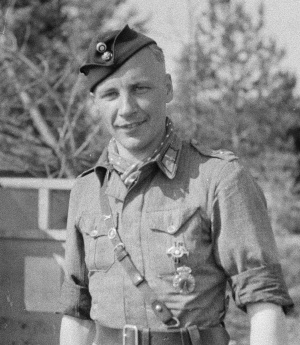
Media
- Skins
- Videos
See also
- Related development
External links
| Brewster Aeronautical Corporation | |
|---|---|
| Fighters | F2A-1 · Thach's F2A-1 · F2A-3 |
| Export | ▄B-239 |
| USA fighters | |
|---|---|
| P-26 Peashooter | P-26A-33 · P-26A-34 · P-26A-34 M2 · P-26B-35 |
| P-36 Hawk | P-36A · Rasmussen's P-36A · P-36C · ○P-36C · P-36G |
| P-39 Airacobra | P-400 · P-39N-0 · P-39Q-5 |
| P-40 | P-40C · P-40E-1 · P-40E-1 TD · P-40F-10 |
| P-43 Lancer | P-43A-1 |
| P-47 Thunderbolt | P-47D-22-RE · P-47D-25 · P-47D-28 · P-47M-1-RE · ⋠P-47M-1-RE · P-47N-15 |
| P-51 Mustang | P-51 · P-51A (Thunder League) · P-51C-10 · P-51D-5 · P-51D-10 · P-51D-20-NA · P-51D-30 · P-51H-5-NA |
| P-63 Kingcobra | P-63A-5 · P-63A-10 · P-63C-5 · ␠Kingcobra |
| Prototypes | XP-55 |
| F2A Buffalo | F2A-1 · Thach's F2A-1 · F2A-3 |
| BF2C | BF2C-1 |
| F3F | F3F-2 · Galer's F3F-2 |
| F4F Wildcat | F4F-3 · F4F-4 |
| F4U Corsair | F4U-1A · F4U-1A (USMC) · F4U-1D · F4U-1C · F4U-4 · F4U-4B · F4U-4B VMF-214 · F2G-1 |
| F6F Hellcat | F6F-5 · F6F-5N |
| F8F Bearcat | F8F-1 · F8F-1B |
| Other countries | ▃Ki-43-II · ▃Ki-61-Ib · ▃A6M2 · ▃Bf 109 F-4 · ▃Fw 190 A-8 · ▃Spitfire LF Mk IXc |


